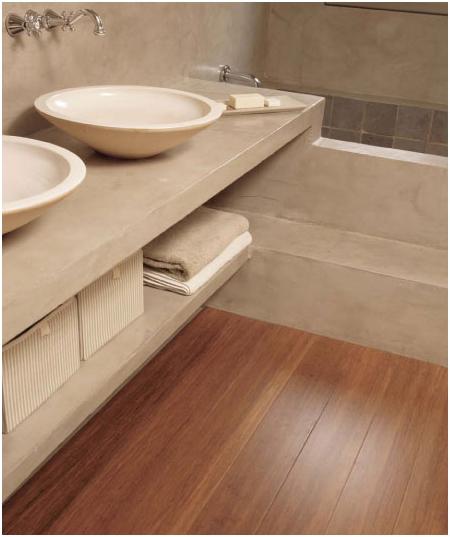Wood Flooring in the bathroom
Parquet in the Bathroom: wooden floors for the bathroom, in oak and bamboo
The best wood flooring for bathroom it must take into account the different dynamics that arise in a material as precious as wood.
The changes in water content inside the wooden floor have the effect, below the value of 30%, the onset of withdrawals is swellings which, in turn, are conditioned by the anatomical directions (axial, radial, tangential).
Passing, in fact, from the fresh state to the normal humidity of 12%, a shrinkage of the order of 0.2 %-0,3% in the axial direction, of 2-3% in the radial direction and of 4-6% is observed. in the tangential direction (these values are expressed as a percentage of the dimensions in the fresh state).
The oak and the bamboo (if well seasoned and worked) they are excellent parquet also like parquet in the bathroom and kitchen .
The difference between the last two retreats, radial is ring road , is the cause of the formation of cracks on felled logs that are not kept adequately moist or the cracks and deformations that occur on the boards during the seasoning phase and beyond, once the wood-based product has been installed.
 The relationship between the two main withdrawals it is sometimes referred to by the term nervousness , is characteristic of every wood species but, like other properties, it can also vary within the same plant. A’ serious company , when it guarantees that its parquet are also suitable for installation in the bathroom , must know the various problems inherent in the nature of wood and act accordingly.
The relationship between the two main withdrawals it is sometimes referred to by the term nervousness , is characteristic of every wood species but, like other properties, it can also vary within the same plant. A’ serious company , when it guarantees that its parquet are also suitable for installation in the bathroom , must know the various problems inherent in the nature of wood and act accordingly.
If we take for example a fresh trunk and we section it longitudinally, obtaining tables all of the same size, after having waited for equilibration to humidity values close to 12%, we realize that the various tables behaved differently: those obtained in the outermost areas, near the cortex, have undergone much more substantial deformations than those found on the tables corresponding to the more central areas, near the medulla.
This is to be related to the different amplitude of the angle formed by the annual ring with respect to the sides of the boards which allows the tangential shrinkage, already naturally higher than the radial one, to act on a greater surface, consequently causing substantial deformations.
The deformation described above, caused by the diversity of tangential shrinkage with respect to radial shrinkage, is called embarkation , a term which, however, in common practice, is used for any change in the shape of a wood element that occurs after its processing.
On the contrary, there are other terms such as twist , arching , mowing to indicate the other types of deformation of the boards generally due, not only to the difference between tangential and radial shrinkage, but also to the presence of defects such as deviated grain and reaction wood (anomalous wood that forms when the plant has grown in particular conditions such as for example on sloping ground, in windy stations, etc.).
Fig. 6Main deformation modes of a parquet board:
A) arching, B) mowing, C) twisting, D) embarkation
Returning to the different behavior of the various wood species, a very precise way to characterize the behavior of a given timber against humidity is represented by the dimensional variation coefficient .
This characteristic, sometimes identified with other names such as “ specific shrinkage / swelling ”Or“ unit shrinkage / swelling ”, unfortunately it is not adequately known, but it allows to identify the dimensional variations of the wood as each percentage point of its humidity varies. Given the non-linearity of the correlation between shrinkage / swelling and variations in the quantity of water contained in the wood, it would be advisable to determine the behavior of each species around the humidity assumed by the material once it has been installed. In general, the value of the coefficient fluctuates between 0.15 and 0.6 (of dimensional variation per 1 of humidity variation); currently only partial data are available and refer to a few wood species.
Information contained in the book “The Parquet from design to installation” by EdilegnoArredo and AIPPL







